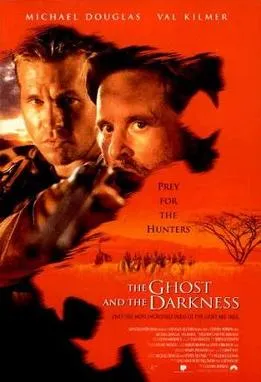Historical accuracy of The Ghost and the Darkness

Historical accuracy of The Ghost and the Darkness

Characters
Lt. Col. John H. Patterson
Based on the real engineer who oversaw the Tsavo bridge construction and wrote the book The Man-Eaters of Tsavo. The film depicts his actual role in hunting the lions.
Charles Remington
A completely fictional character created for the film, played by Michael Douglas. Patterson hunted the lions primarily himself, sometimes with assistants, but not with a famous American hunter.
Samuel
Represents the skilled local workers and foremen involved in the project and potentially assisting Patterson. Likely a composite character rather than based on a specific named individual.
Robert Beaumont
Represents the pressure from the Imperial British East Africa Company overseeing the railway project. Beaumont himself is likely a fictional or composite figure embodying these pressures.
Dr. David Hawthorne
Represents the medical personnel present at the construction site dealing with injuries and illness. Likely a fictional or composite character.
Angus Starling
Represents the on-site British supervisors working under Patterson. Likely a fictional or composite character.
More characters
Abdullah
Represents the leaders among the diverse workforce (which included many Indian laborers). Likely fictional or composite.
Mahina
Represents the local assistants Patterson relied upon. While Patterson did have assistants, Mahina's specific portrayal and death in the film (cremation, which is against Islam) are fictionalized.
Helena Patterson
Based on Patterson's real wife, Frances Helena Gray. The film correctly shows he was married, but invents her pregnancy during the Tsavo incident (their son was born much later, in 1909).
Story
Railway bridge construction in Tsavo
The construction of a railway bridge over the Tsavo River in British East Africa (Kenya) in 1898 is the factual basis of the story.
Patterson hired to build bridge
Lt. Col. John Henry Patterson, an Anglo-Irish military engineer, was indeed assigned by the British authorities to oversee the bridge construction.
Man-eating lions attack workers
Two male lions did repeatedly attack and kill railway workers over several months in 1898, creating terror and halting construction.
Number of victims (135 claimed)
The film uses Patterson's high estimate of 135 victims. Scientific analysis of the lions' remains suggests a much lower number (around 35), though the exact total is still debated.
Charles Remington helps Patterson hunt
The character Remington and his involvement in the hunt are entirely fictional. Patterson hunted the lions himself, with assistance from local staff and eventually some Sepoys (Indian soldiers).
Attack on the camp hospital
The dramatic scene where a lion attacks the makeshift hospital, dragging victims out, is a fictionalized event created for the film to heighten the terror.
Discovery of lions' den with bones
Patterson claimed years later to have found a cave with human remains. The film depicts this during the 1898 hunt, exaggerating it as a lair filled with skeletons, which is likely fictional embellishment.
Lions depicted with manes
The real Tsavo lions were males but largely maneless, a characteristic feature of lions in that region. The film used maned lions, likely for aesthetic reasons and availability of trained animals.
Killing the first lion
Patterson did use a scaffold (machan) but used a donkey, not a baboon, as bait. He wounded the first lion initially and killed it later after tracking it, not quite as depicted in the single encounter.
Killing the second lion
Patterson did kill the second lion, requiring multiple shots over a period of tracking. The film dramatizes the final confrontation significantly.
Remington killed by second lion
Since Remington was fictional, his dramatic death did not occur.
Workers' fear halts construction
The lion attacks caused widespread panic among the diverse workforce (largely Indian laborers), leading hundreds to flee and bringing the railway construction to a standstill for weeks.
Supernatural aspect ("Ghost," "Darkness")
The lions were nicknamed "Ghost" and "Darkness" due to their cunning. The film plays up the local belief in them being supernatural entities, reflecting some contemporary superstitions/fears.
Setting
Tsavo region, Kenya, 1898
Accurately sets the story in the correct time and general location in British East Africa during the Scramble for Africa period.
Landscape portrayal
Filmed primarily in South Africa, the landscape captures an African savanna environment but doesn't perfectly replicate the specific rolling grasslands and scrub of the actual Tsavo area.
Railway construction camp
Realistically portrays the large scale of the temporary work camp, including tents, makeshift structures (hospital), thorn bomas (fences), and the under-construction railway bridge.
Colonial atmosphere / British presence
Reflects the context of British colonial expansion, the hierarchy between British engineers/supervisors and the local African and imported Indian workforce.
Workforce demographics (Indian, African)
Accurately shows the large presence of indentured laborers brought from British India, alongside local African workers, constituting the main workforce for the Uganda Railway construction.
Period costumes and equipment
Clothing for the British characters (colonial wear, formal attire) and workers, along with firearms (like Patterson's rifles) and construction tools, generally reflect the late Victorian era.
Depiction of lion behavior
While based on real man-eating lions, the film likely exaggerates their cunning, seeming invulnerability, and coordinated attacks for dramatic effect. Their motive remains scientifically debated.
